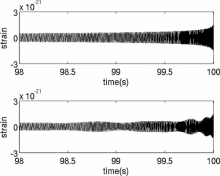
Abstract
Wereport on the methods and results of the first dedicatedsearch for gravitational waves emitted during the inspiral of compactbinaries with spinning component bodies. We analyze 788 hours ofdata collected during the third science run (S3) of theLIGO detectors. We searched for binary systems using a detectiontemplate family specially designed to capture the effects of thespin-induced precession of the orbital plane. We present details ofthe techniques developed to enable this search for spin-modulated gravitationalwaves, highlighting the differences between this and other recent searchesfor binaries with nonspinning components. The template bank we employedwas found to yield high matches with our spin-modulated targetwaveform for binaries with masses in the asymmetric range 1.0M[sun]<m1<3.0M[sun]and 12.0M[sun]<m2<20.0M[sun] which is where we would expect the spinof the binary's components to have a significant effect. Wefind that our search of S3 LIGO data has goodsensitivity to binaries in the Milky Way and to asmall fraction of binaries in M31 and M33 with massesin the range 1.0M[sun]<m1, m2<20.0M[sun]. No gravitational wave signals wereidentified during this search. Assuming a binary population with spinningcomponents and Gaussian distribution of masses representing a prototypical neutronstar–black hole system with m1~=1.35M[sun]and m2~=5M[sun], we calculate the90%-confidence upper limit on the rate of coalescence of thesesystems to be 15.9 yr-1L10-1, where L10 is 1010 times theblue light luminosity of the Sun.